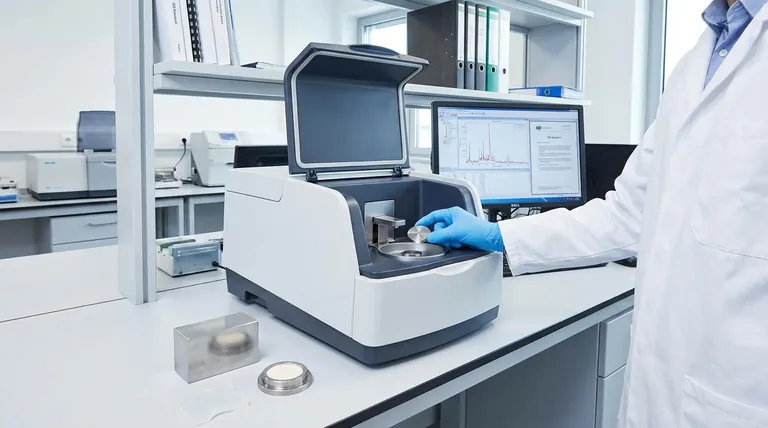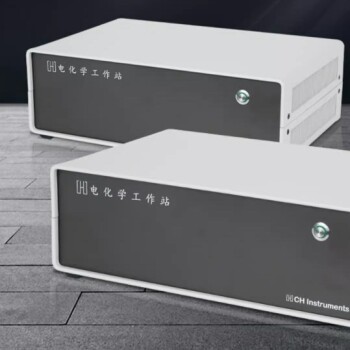There is no single, universal ISO standard for XRF analysis. Instead, the International Organization for Standardization (ISO) publishes numerous standards that apply the technique of X-ray Fluorescence (XRF) to specific materials and applications. The correct standard depends entirely on what you are analyzing—be it a metal alloy, a plastic polymer, a cement sample, or a geological specimen—and the specific elements you need to quantify.
The central challenge is not finding "the" XRF standard, but rather identifying the correct ISO standard for using XRF to analyze your specific material for your specific purpose. This distinction is critical for ensuring accurate, repeatable, and defensible results.

Why Standards are Application-Specific
An ISO standard is essentially a documented procedure that, when followed, ensures consistency and comparability of results between different labs and operators. For a technique as sensitive as XRF, a one-size-fits-all approach is impossible.
The Critical Role of the Sample Matrix
The "matrix" is everything in the sample that is not the element you are trying to measure. This matrix significantly influences the X-ray signals through absorption and enhancement effects.
A standard for analyzing stainless steel cannot be used for an aluminum alloy because their matrices interact with X-rays in fundamentally different ways, which would lead to grossly inaccurate results.
Defining the Analytical Goal
Standards are almost always written for quantitative analysis, which requires precise and accurate results. This necessitates strict controls over every step of the process.
The standard will define critical parameters like sample preparation techniques, required calibration standards, and measurement conditions tailored to achieve a specific level of accuracy for a given material.
Wavelength vs. Energy Dispersive (WDXRF vs. EDXRF)
Some standards are developed with a specific type of XRF instrumentation in mind.
WDXRF offers higher resolution and is often preferred for complex alloys or trace element analysis. EDXRF is typically faster and more common in portable devices. A standard may specify or provide guidance for one method over the other.
Key Examples of ISO XRF Standards
To illustrate the specificity, consider these examples from different fields. This is not an exhaustive list but a representative sample.
For Metals and Alloys
Standards in this area are numerous and highly specific to the alloy family.
- ISO 14793: "Founding — Spectrometric analysis by spark optical emission and X-ray fluorescence" provides general guidelines.
- ISO 18118: "Chemical analysis of nickel alloys — X-ray fluorescence spectrometric analysis" is an example of a standard tailored to a specific alloy group.
For Cements and Minerals
The construction and geological industries rely heavily on XRF for quality control.
- ISO 29581-2: "Cement — Test methods — Part 2: Chemical analysis by X-ray fluorescence" is the definitive standard for analyzing the elemental composition of cement.
For Plastics and Regulatory Compliance (RoHS)
XRF is a primary tool for screening for restricted hazardous substances.
- IEC 62321: While technically from the International Electrotechnical Commission (IEC), this is the globally recognized standard for determining levels of regulated substances (like lead, mercury, cadmium) in electronics. XRF is the specified screening method in Part 3-1.
For General Methodology
Some standards address the XRF technique itself rather than a specific product.
- ISO 9516 series: This set of standards, such as "Iron ores — Determination of various elements by X-ray fluorescence spectrometry," provides foundational methods that can be adapted.
Understanding the Pitfalls and Considerations
Navigating the world of standards requires careful attention to detail to avoid common errors that can invalidate your results.
Using the Wrong Standard
This is the most critical mistake. Applying a standard for one material to another will produce incorrect data due to uncorrected matrix effects. The procedure and calibration defined in the standard are only valid for the material it was written for.
The Importance of Calibration
No standard can compensate for poor calibration. Accurate quantitative XRF analysis is impossible without proper Certified Reference Materials (CRMs). The ISO standard will often specify the types of CRMs required to establish a valid calibration curve.
Screening vs. Definitive Analysis
Be clear about your objective. Handheld XRF analyzers are excellent for rapid screening (e.g., sorting scrap metal or checking for RoHS compliance). However, if a dispute arises or high-precision certification is needed, the relevant standard will often require follow-up analysis using lab-based WDXRF or other chemical methods.
How to Find the Right ISO Standard for Your Needs
To identify the correct procedure for your work, you must begin with your specific application.
- If your primary focus is analyzing metal alloys: Search the ISO database using keywords like "XRF," "spectrometry," and the specific metal family, such as "aluminum alloy," "copper," or "stainless steel."
- If your primary focus is regulatory compliance (e.g., RoHS, CPSIA): Search for the regulation itself. The regulatory document will specify the legally mandated test methods, such as the IEC 62321 series.
- If your primary focus is working with cements, minerals, or soils: Look for standards from industry-specific technical committees within ISO that cover construction materials, mining, or environmental quality.
- If your primary focus is establishing a general lab procedure: Investigate fundamental standards that cover spectrometric methods to understand the core principles of valid calibration and measurement.
By focusing first on your material and analytical goal, you can confidently navigate the ISO framework to find the correct standard, ensuring your results are accurate, repeatable, and globally recognized.
Summary Table:
| Application Area | Example ISO/IEC Standard | Purpose |
|---|---|---|
| Metals & Alloys | ISO 14793, ISO 18118 | Guidelines for spectrometric analysis of specific alloys like nickel |
| Cement & Minerals | ISO 29581-2 | Chemical analysis of cement by XRF |
| Plastics & RoHS Compliance | IEC 62321-3-1 | Screening for hazardous substances in electronics |
| General Methodology | ISO 9516 series | Foundational methods for iron ores and adaptable use |
Ensure your XRF analysis is accurate and compliant with the right ISO standards. KINTEK specializes in providing high-quality lab equipment and consumables, including XRF systems and Certified Reference Materials (CRMs), to support your specific material testing needs. Our expertise helps laboratories achieve precise, repeatable, and defensible results. Contact us today to discuss how we can enhance your analytical workflow!
Visual Guide

Related Products
- Lab Electrochemical Workstation Potentiostat for Laboratory Use
- Three-dimensional electromagnetic sieving instrument
- Automatic Laboratory Heat Press Machine
- Infrared High Resistance Single Crystal Silicon Lens
- Infrared Thermal Imaging Temperature Measurement Double-Sided Coated Germanium Ge Lens
People Also Ask
- Why is melting point important for substance identity and purity? A Key Indicator of Sample Composition
- What parameters and phenomena should be monitored during an experiment using the electrolytic cell? Ensure Safe and Efficient Electrolysis
- What are the limitations of electrochemical deposition? Overcome ECD's Constraints for Your Application
- What are the key safety operation guidelines for using the electrolytic cell? Essential Protocols for Lab Safety
- Which technique has an excellent sensitivity for elemental analysis? ICP-MS Leads for Ultra-Trace Detection










